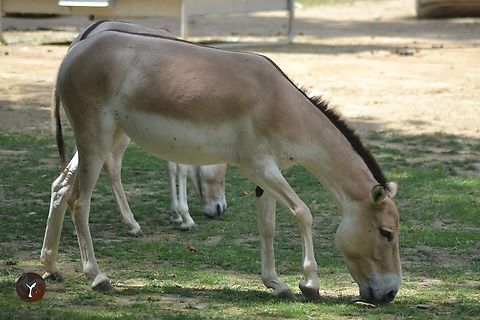
Appearance
The Turkmenian kulan is one of the largest subspecies of the onagers. It is 200–250 cm long, 100–140 cm tall at the shoulder, and it weighs 200–240 kg. Male onagers are larger than the females.The Transcaspian wild ass is characterized by a pale brown coat, a dark stripe down the spine and white patches on the sides, back and belly. It also has shaggy black mane and a tuft at the tail end. During the summer, the Turkmenian kulan's coat is leaner and brown, then it turns into thick grayish-brown winter coat during the cold season.
Naming
* Mongolian wild ass, "Equus hemionus hemionus"⤷ Persian onager, "Equus hemionus onager"
⤷ Indian wild ass, "Equus hemionus khur"
⤷ Syrian wild ass or hemippe, "Equus hemionus hemippus"
Status
In early 1919, the Soviet Union placed the Turkmenian kulan under protection. However, the measures enacted in their favor have not saved them from local extinctions, such as in Kazakhstan, where the subspecies disappeared in 1935. The main kulan population has suffered a dramatic decline in recent years. Badkhyz was the main stronghold and the last habitat of the Transcaspian wild ass which contained a few thousands of individuals, until it was reintroduced in other protected areas in Turkmenistan and other Central Asian countries that was built purposely for the kulans, such as the Gaplaňgyr Nature Reserve, the Çemenebit Sanctuary and the Mäne-Çäçe Sanctuary.As of 1996-1997 the total population of Turkmenian kulan were estimated at between 500 and 700 kulans in Kazakhstan and about 6,000 kulans in Turkmenistan. Of the latter about 5,000 to 6,000 lived in Badkhyz Zapovednik alone and about 1,000 in artificially restored populations elsewhere in Turkmenistan. In Badkhyz, the Turkmenian kulan population has decreased from 6,000 individuals as of 1993 to 2,400 in 1998 and to 650 in 2002. Currently, there are 900 kulans in Badkhyz. Previously in 2005, there were more than 1,300 Turkmenian kulans in Turkmenistan.
Habitat
The Turkmenian kulan lives in Central Asian deltas, hot and cold deserts or semi-deserts, steppes, arid grasslands and shrublands.The Turkmen specimen used to be the most widespread of the onagers, ranging from northernmost Iran and northern Afghanistan, the Transcaspian Oblast and western China to Ukraine and southern Siberia. It used to live in Saryesik-Atyrau Desert of Kazakhstan. However, it has gone extinct from that location.
Food
The Turkmenian kulan are herbivorous mammals. They feed on herbs, shrubbery and plants. Most of their liquid comes from food, although often traveling at water sources, especially when breast-feeding their offspring.The mare lives with foals in small herds. The dominant stallion defends the surrounding areas to the water sources and tries to mate with any females that come close to drink. The mare, after a gestation period of about a year, gives birth to a single foal that stays with her mother for the first two years of life.
The scorching heat of the Central Asian deserts makes the Transcaspian wild ass mostly active at dawn and dusk when temperatures are milder. The kulans, like most onagers, are one of the fastest land mammals and can run at high speed of 70 km/h.
Predators
Like all onagers, the Turkmenian kulan is threatened by poaching, hunting for their meat and their coat, habitat loss and relationships with apex predators such as Persian leopards, striped hyenas and mostly Himalayan wolves. Extinct predators like the Caspian tiger also preyed on the kulan. However, like other onagers, they have anti-predatory protections. Group of stallions can cooperate and chase off the predators.References:
Some text fragments are auto parsed from Wikipedia.